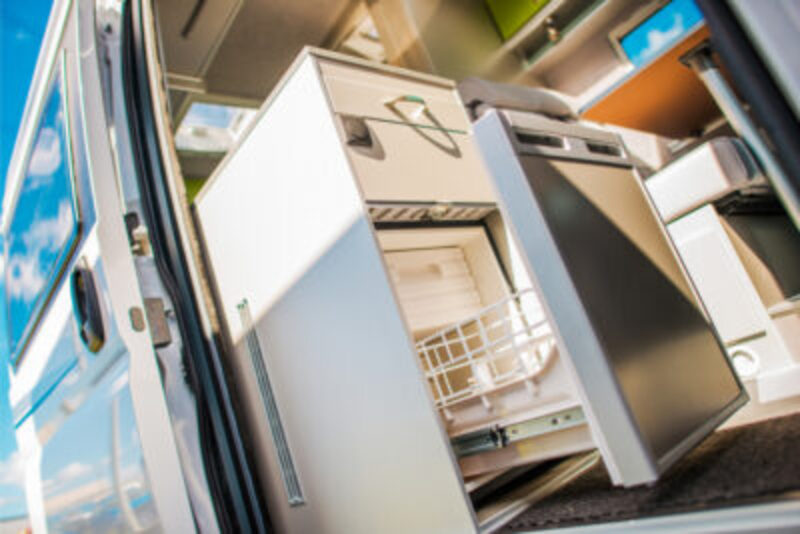Thanks for your support! If you make a purchase using our links in this article, we may make a commission. And, as an Amazon Associate, I earn from qualifying purchases. See the full disclosure here.
If you want to live the van life, you’re going to need a refrigerator. Without one, you’re going to have a tough time keeping fresh produce and meat from spoiling. Also, you won’t be able to enjoy a cold drink.
Choosing the right fridge for your van life can be a big decision. It might be one of the more expensive purchases you make for your build. To help you make the best choice, here are the 7 best fridges for van life.
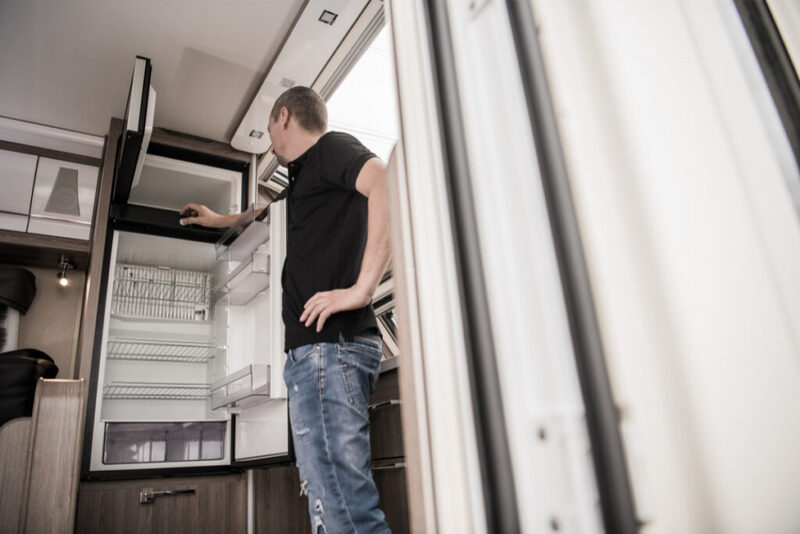
7 Best Fridges for Van Life
So, with no further ado, let’s see the 7 best fridges for van life!
1. Best Dual Zone Fridge and Freezer: Dometic CFX75 Dual Zone 12v Fridge 75 Liter
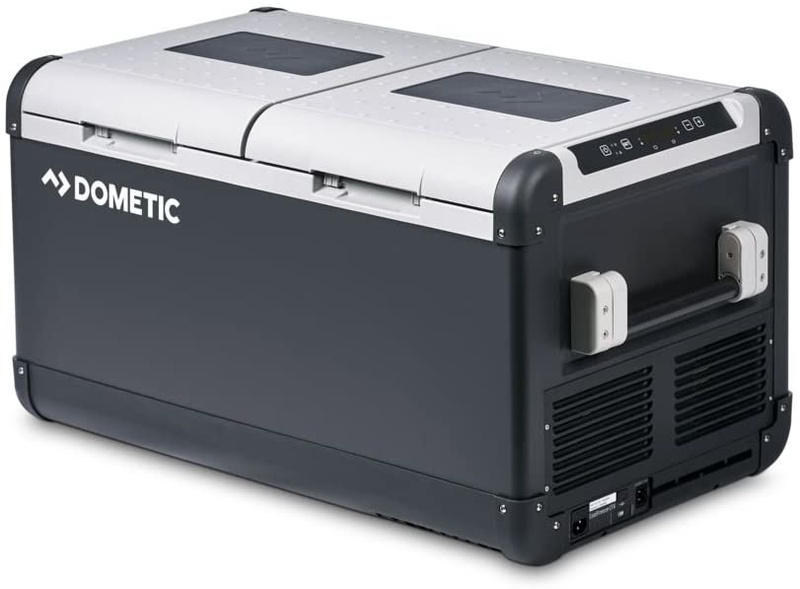
If you’re looking for a dual-zone fridge, look no further than the Dometic CFX75. This fridge’s two compartments can refrigerate or freeze in any combination. So you can have a fridge and a freezer, or two fridges, or two freezers!
This is a compressor refrigerator that can use both AC and DC power. The lowest temperature reaches -7°F (-22°C), and has a capacity of 74 quarts. This fridge holds tons of food and gets it super cold!
It also has some nice extras. This fridge features a 5V, 500mA USB port, so it can be used to charge devices. It also has Wi-Fi connectivity so that you can control it from an app on your smartphone.
Exterior Dimensions: 34.92” x 18.58” x 19.48”
Internal Capacity: 74 quarts / 70 liters / 113 cans
Weight: 68.3 lbs.
Power Source: 100-240v AC or 12/24v DC
Power Consumption: 1.3Ah/h
Opening Style: Top opening
2. Dual Zone Alternative: Alpicool Dual Zone 12v Compressor Fridge 75 Liter
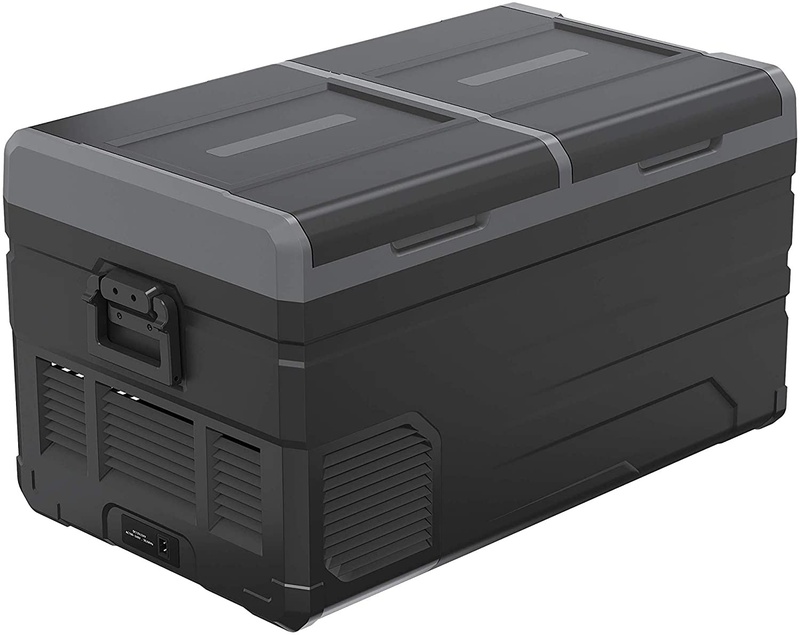
If you’re looking for a dual-zone alternative to the Dometic, then we recommend the Alpicool Dual Temperature Control TW75. Like the Dometic, this fridge’s two compartments can be set to their own distinct temperature.
However, this fridge comes in much cheaper than the Dometic and sacrifices very few features in the process.
Compared to the Dometic, it lacks a USB port, nor can it access Wi-Fi. Its minimum temperature is only -4°F compared to Dometic’s -7°F. Most notably, however, is that it is only designed to run off of DC power, and won’t work with AC.
But if you can deal with those minor differences, the Alpicool is a great deal. And, it has a slightly larger capacity at 80 quarts! Plus, it has a special system to protect your vehicle battery when drawing power from it.
Exterior Dimensions: 32.5” x19.4” x18.3”
Internal Capacity: 80 quarts / 75 liters / 102 cans
Weight: 48.4 lbs
Power Source: 12V/24V DC
Opening Style: Top opening
3. Best Durable Fridge: ARB Compressor 12v Fridge – 63 Quarts
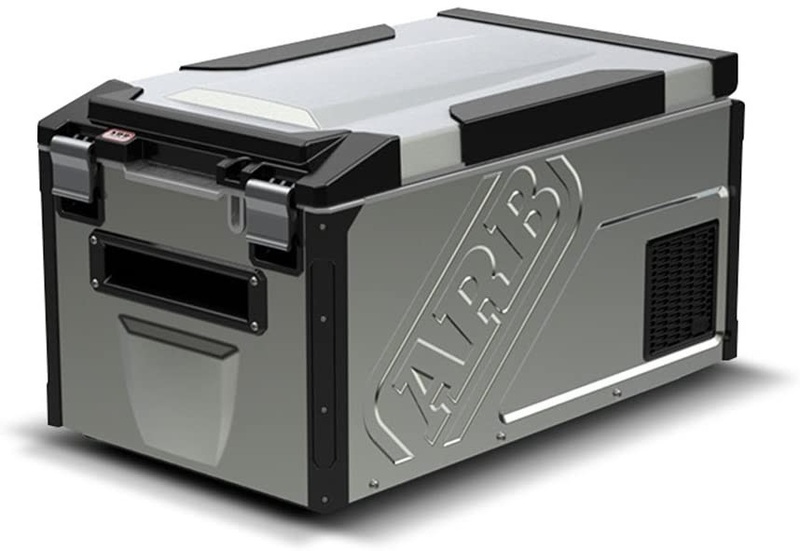
Looking for a rugged fridge that can withstand nearly any condition? The ARB 10810602 is for you. This fridge is built from weatherproof stainless steel and is designed to be extremely sturdy.
This is a compressor fridge that can run off either AC or DC power. Its top-opening lid features an “infinite position” gas strut which will hold the lid open at any angle. It has a 4-digit pin lock for the controls, as well as a place to attach a padlock.
If you need a heavy-duty fridge created with adventure in mind, the ARB is a great choice. In addition to the weatherproof construction, it features ASA plastic protective pieces to keep it extra safe.
Exterior Dimensions: 37” x 24” x 22”
Internal Capacity: 63 quarts / 59.6 liters
Weight: 70 pounds
Power Source: AC or DC power
Opening Style: Top opening
4. Cheapest 12v Compressor Fridge: Alpicool CF45 Fridge 48 Quart
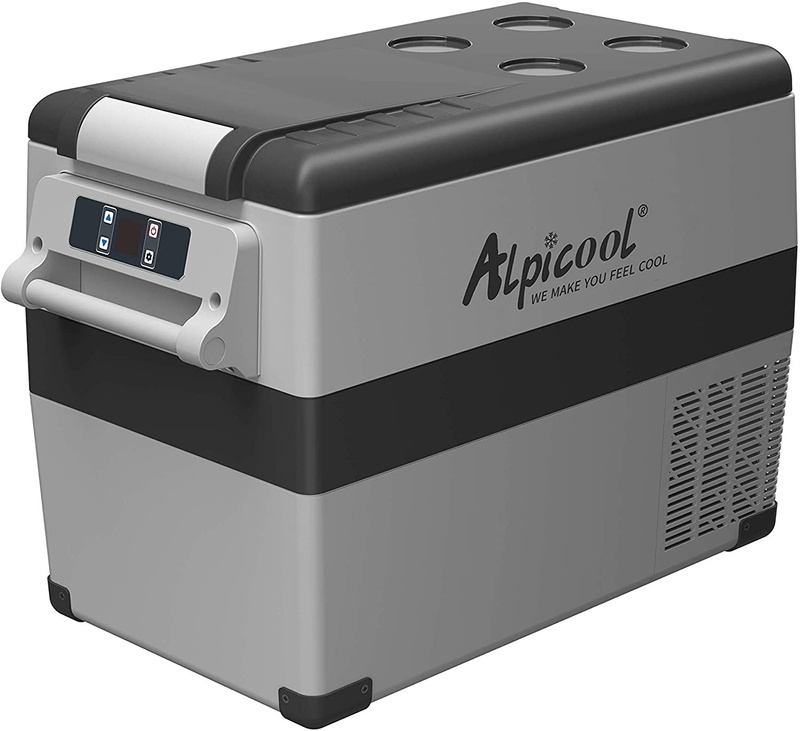
The Alpicool CF45 is the best option for those on a budget. This fridge comes in as the cheapest on our list but, still provides a great fridge with plenty of power.
This is a compressor fridge with a minimum temperature of -4°F. It’s designed for use with both DC and AC power, so you can run it using shore battery power. Plus, it features a battery protection system.
This fridge also has handles for easy transport. Although they’re not advertised as such, the round divots on top can be used as shallow cup holders.
With one compartment, the Alpicool CF45 can be used as a fridge or freezer. This van fridge is designed to run quietly.
Exterior Dimensions: 27.2” x 13.6” x 18.2”
Internal Capacity: 48 quarts / 45 liters
Weight: 30 pounds
Power Source: AC or DC power
Power Consumption: 45 watts (amp hours not given)
Opening Style: Top opening
5. The Most Efficient 12v Fridge: Dometic Drawer-Style 12v Fridge
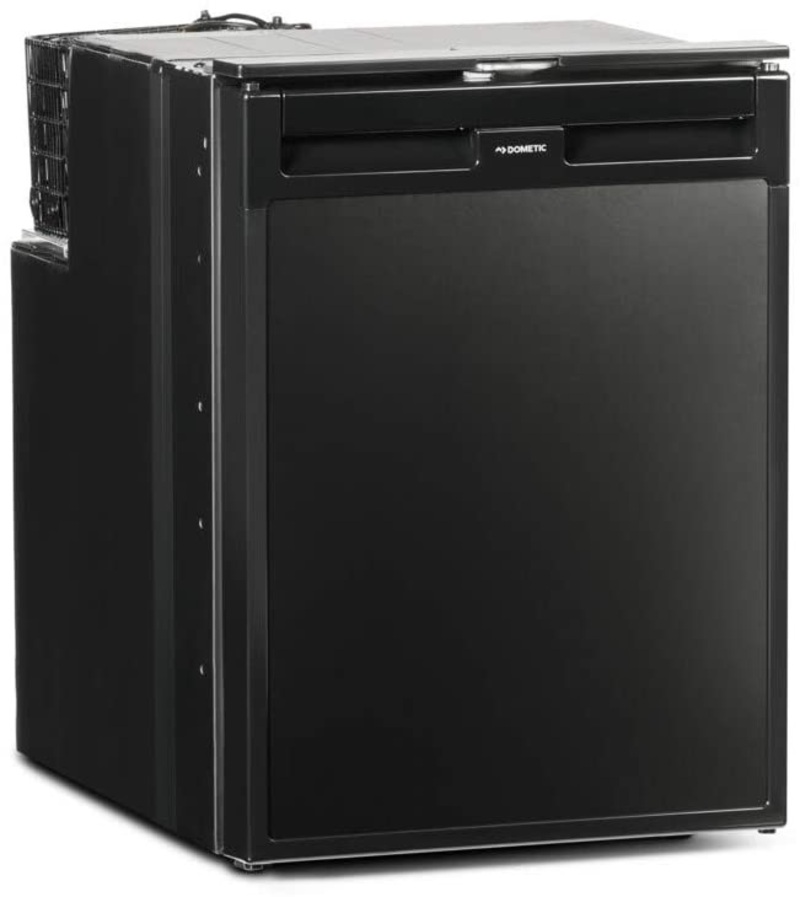
If you want a drawer refrigerator, then the Dometic CD-50 is a great choice. This fridge features a spacious pull-out drawer that pulls out easily on ball-bearing slides. Plus, it has a keyed lock to keep it secure.
Like all Dometic fridges, this is a high-quality fridge designed for use in RVs, vans, or SUVs. Specifically, this is a compressor fridge for maximum power and flexibility. However, unlike some other fridges, it only uses DC power.
Exterior Dimensions: 19.7” x 21.3” x 15”
Internal Capacity: 50 quarts / 47 liters / 1.65 cubic feet
Power Source: DC power
6. The Best Upright Fridge For Van Life: Dometic Upright CRX-65 12v Compressor Fridge
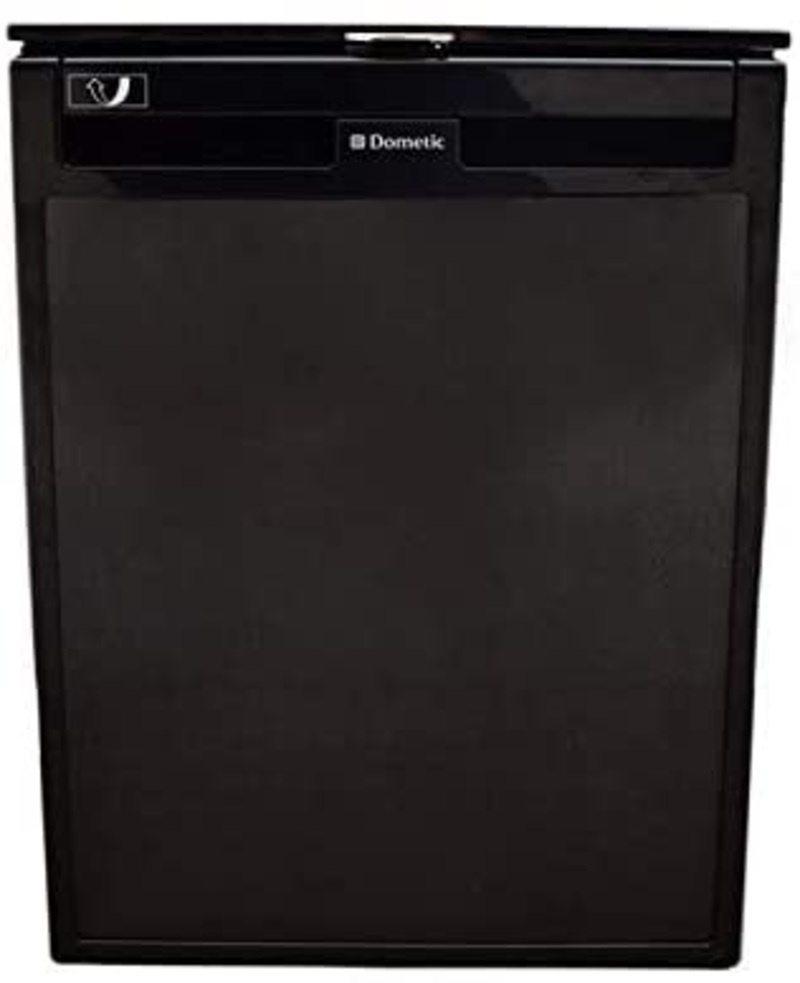
Do you want a front-opening fridge that’s a bit more like what you have at home? Consider the Dometic CRX-65. This is a compact, front-opening fridge with a removable freezer compartment.
This fridge is designed to be flexible and can be used as a fridge, freezer, or both. With van life in mind, it’s designed to make minimal noise, as the fan automatically adjusts to the ambient temperature. Inside, you’ll find three shelves, plus a small shelf inside the door for drinks or condiments.
This fridge uses compressor technology and runs off of DC power.
Exterior Dimensions: 17.6” x 20.7” x 21.5”
Internal Capacity: 60 quarts / 57 liters
Power Source: DC power only
Opening Style: Front opening
7. Best Overall Value Van Fridge: Iceco 45 Liter 12v Compressor Refrigerator
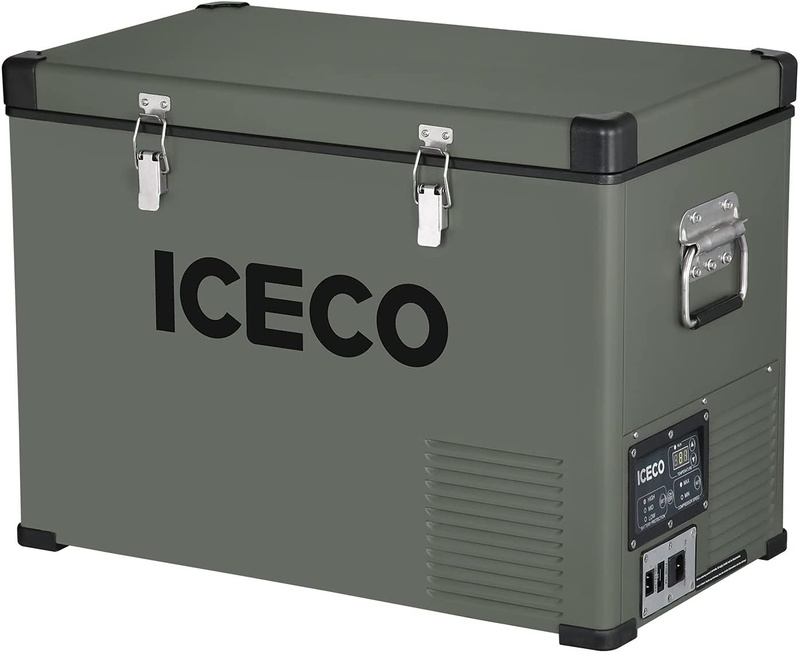
The final fridge on our list is the unique-looking ICECO VL45. The steel casing and handles give it an old-fashioned look, but don’t let that fool you – this fridge is powerful and modern. It has an anti-fingerprint finish to keep it looking sleek and clean.
This fridge has a high-quality SECOP compressor that has a whopping 5-year warranty backing it up. The ventilation is designed to be water-resistant and allow for heat dissipation.
Besides those features, the ICECO VL45 also features a 3 level battery protection system to avoid running down your batteries. It also has corner guards to protect the fridge, or your cabinetry, when you move it around.
The only major downside to the ICECO is it doesn’t get quite as cold as other fridges on this list. The ICECO VL45’s minimum temperature is 0°F, compared to -4 to -7°F. However, the FDA recommends your freezer be set to 0°F and your refrigerator to 40°F so you’re well within those guidelines.
Exterior Dimensions: 25.9” x 14.7” x 18.8”
Internal Capacity: 47.5 quarts / 45 liters / 72 cans
Power Source: 110-240v AC
Opening Style: Top opening
3 Types of Fridges for Van Life
There are a few different refrigeration technologies used in RV fridges:
- Compression refrigerators
- Absorption refrigerators
- Thermoelectric coolers
Each comes with unique advantages and disadvantages.
Compressor Fridges
The first type of fridge is the compressor refrigerator. This is the most common type of fridge – and more than likely the kind of fridge you have at home.
This technology is quite old; commercial compressor fridges have existed since at least 1918. Partly because it’s been around so long, compressor fridge technology is very safe, efficient, and reliable.
How Does a Compressor Fridge Work?
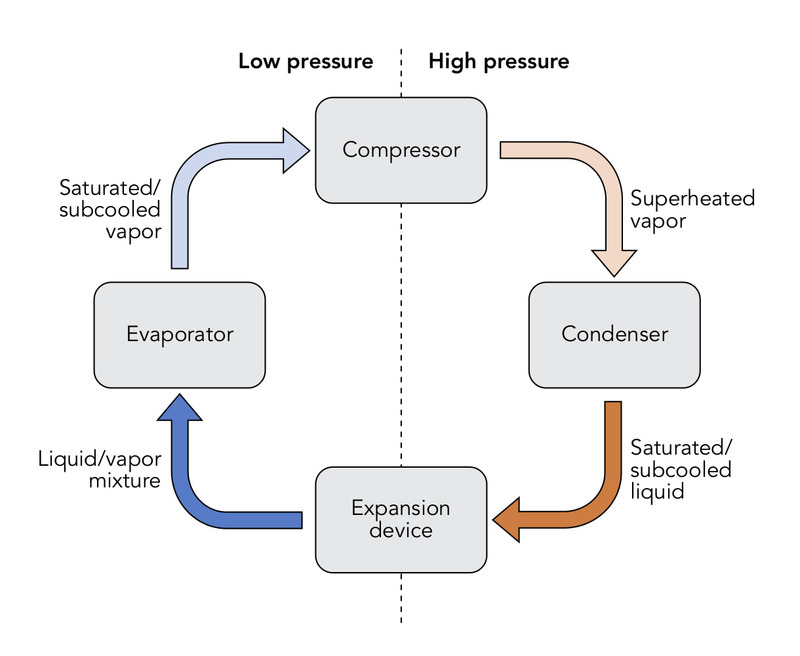
Like most fridges, a compressor fridge utilizes a refrigerant. A refrigerant is a substance with low boiling points (as well as other important properties). Refrigerants are transitioned from a liquid to a gas and back again, causing a cooling effect.
A compressor fridge uses a compressor, a series of tubes, and fans to keep the fridge cold. The vapor compression refrigeration cycle which powers your compression fridge has four stages:
- The refrigerant enters the compressor as a vapor with low pressure. It is then compressed into a high-pressure vapor, causing it to become superheated.
- The hot vapor refrigerant then passes through a series of S-shaped tubes called the condenser. As the hot vapor flows through the condenser, cool air is blown across the tubes. This process causes the refrigerant to change from a vapor to a liquid, while still under high-pressure.
- The refrigerant now passes through a metering device or expansion valve. This maintains high pressure on the end where the refrigerant enters and low pressure where it exits. This causes the refrigerant to expand and reduce in pressure, cooling it down as it flows.
- Finally, the refrigerant enters another series of tubes called the evaporator. A fan blows warm air over the tubes and the cold refrigerant absorbs the heat from the warm air. As the evaporator absorbs the heat from the air, it reduces the temperature of the inside of the refrigerator. The refrigerant absorbing the heat begins to boil, changing to a low-pressure vapor, is pulled back into the compressor, and starts the process over.
What Are the Pros and Cons of Compressor Fridges?
Overall, compressor fridges have a lot of pros making it easy to see why they’re so popular. However, they aren’t without some downsides.
Pros
- Compressor refrigeration is very powerful. It can get your food colder and faster than other types of fridges.
- A compressor fridge doesn’t need to be level, unlike an absorption refrigerator, to work.
- These fridges are not affected by high altitudes.
- Overall, the compressor fridge’s efficiency outweighs absorption versions.
Cons
- Compressor fridges can be a bit noisy, especially older models.
- Compressor fridges may require an upgraded battery bank, especially for boondockers.
Can I Use a Residential Fridge in My RV?
An “RV residential fridge” is the same kind of fridge you would see in your bricks-and-sticks home – it’s just installed in your RV or van. Residential fridges use compressors to keep the contents cold and use AC power to run.
It’s entirely possible to use a residential fridge in your van, but you’ll run into some limitations. To operate a residential fridge, you’ll need to be connected to AC power. Unlike other types of van refrigeration, residential fridges don’t run off propane or DC current; they use AC power at all times to stay cool.
In order to power your fridge for van life situations, you’ll need to be connected to shore power, a generator, or a battery bank with an inverter. A generator will generate 120v AC power using some kind of fuel. An inverter, meanwhile, takes the 12v DC power from your batteries and “inverts” it into 120V AC power.
Absorption Refrigerators
The next type of RV fridge is the absorption refrigerator. There are several features that make absorption fridges for van life attractive. Unlike compressor fridges, absorption refrigerators have few-to-no moving parts; they require only a heat source to work. In some cases, propane will power your absorption fridge when electricity is unavailable.
This technology was first invented way back in 1858. In the 1960s, they began being sold to RVers under the still hugely popular Dometic brand.
How Do Absorption Refrigerators Work?
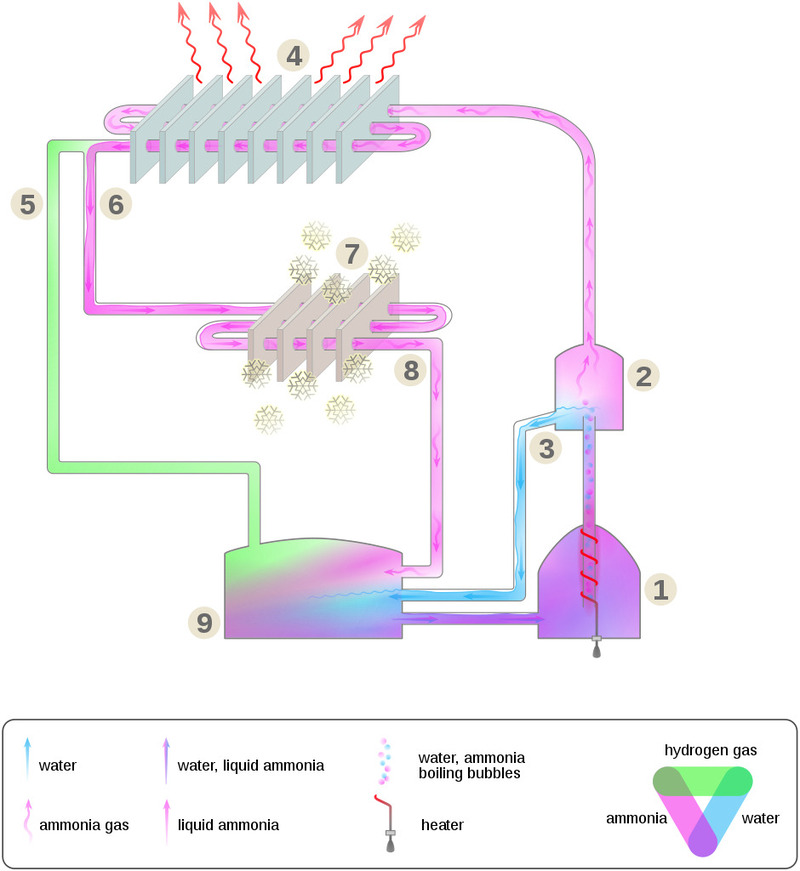
An absorption fridge works on the same basic principle as a compressor fridge. A refrigerant is heated, changing it from a liquid to a gas. It is then condensed, cooled back into a liquid, and the cycle starts over.
The vapor absorption refrigeration cycle has three stages:
- Evaporation – The refrigerant starts as a liquid under low pressure. Because of the low pressure, the refrigerant boils at a low temperature extracting heat from its surroundings.
- Absorption – The now-gaseous refrigerant is absorbed by a special salt solution. This is where this technology gets its name.
- Regeneration – The refrigerant- saturated liquid is heated and the refrigerant gas evaporates. The hot gas passes through the heat exchanger, losing heat to the outside ambient air. The heat loss causes the gas to condense to a liquid and then the cycle repeats.
An absorption fridge can use an electrical heat source, usually powered by 120v AC – some may use 12v DC. But, the boiler can be heated by propane, using a flame as the heat source.
What are the Pros and Cons of Absorption Refrigerators?
Absorption fridges have several attractive qualities for van life. But, they’re not without some drawbacks.
Pros
- They only need a source of heat to work, so absorption fridges are very flexible with their power sources. Absorption fridges will be either “two way” (using 120v AC or propane) or
“three way” (using 120v AC, propane, or 12v DC). - Absorption fridges are great if you’ll be on the road all day or away from shore power because they can use propane. They’re also handy for boondocking.
- Because they don’t use a compressor, absorption fridges run completely silent.
Cons
- Absorption fridges take longer to cool down than compressor versions. They also don’t cool as evenly or efficiently. They have to work harder in warm temperatures.
- You have to keep an absorption fridge properly leveled for it to function properly. If your van is parked on an angle, the flow of gas and liquids won’t flow correctly, so the cooling process will be inefficient or ineffective.
- Because they use propane gas, absorption fridges need to have good ventilation.
Thermoelectric Coolers
The final type of RV “fridge” is the thermoelectric cooler. They are also known as electric coolers and don’t reach the temperatures that a compressor or absorption refrigerator maintains.
But, that doesn’t mean thermoelectric coolers aren’t a good option. Due to their unique characteristics, the advantages of an electric chest-style fridge for van life can be amazing.
How Do Thermoelectric Coolers Work?
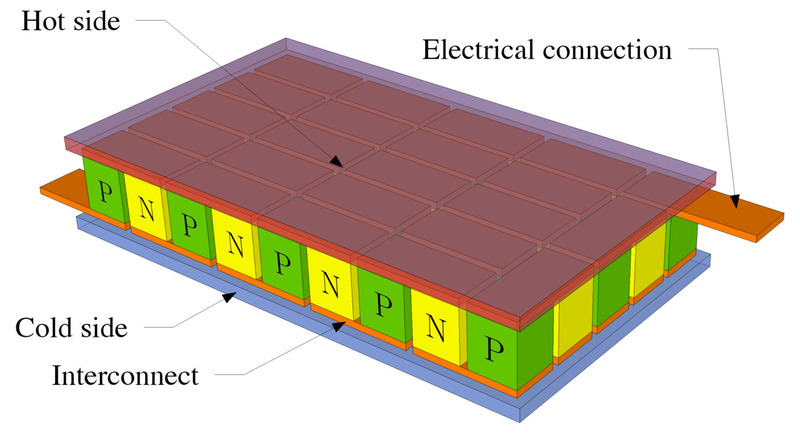
Unlike compressor and absorption fridges, thermoelectric coolers do not use any refrigerant or coolant of any kind. Nor do they have any kind of moving parts or tubing.
Instead, thermoelectric coolers work using electrical current alone. The exact details of this are even more complicated than other fridges, using something called the “Peltier effect.”
Basically, a thermoelectric cooler passes an electrical current between two different materials. This removes heat from one end and transfers it to the other, creating a cooling effect. In fact, thermoelectric “coolers” can also be used for heating by utilizing the “hot side” of the device.
Getting a bit more in-depth, a thermoelectric cooler contains an array of two different types of semiconductors sandwiched between ceramic or metal plates. These are known as “n-type” and “p-type” semiconductors.
The specifics of these semiconductors are, of course, pretty complex. But basically, an “n-type” semiconductor has extra electrons and is named for the electron’s negative charge. “P-type” semiconductors have a “hole” that accepts electrons and are named for the hole’s positive charge.
The array of semiconductors in a thermoelectric cooler alternate between n- and p-type. When current passes from the n-type to the p-type, temperature decreases on the “cold side” of the device due to the movement of electrons.
What are the Pros and Cons of Thermoelectric Coolers?
A thermoelectric cooler’s unique properties give these fridges for van life excellent practical uses. However, they also have a couple significant downsides.
Pros
- They take up very little space in your van because they don’t need refrigerant or complicated tubing and mechanics. Manufacturers can make thermoelectric coolers very small and compact.
- These electric coolers are highly portable due to their small size. Some even have handles or wheels to help you move them around easily.
- Thermoelectric coolers are completely silent because they have no moving parts.
- Thermoelectric coolers don’t require the use of any refrigerants, which can be toxic to the environment.
- You can power them off your battery bank without an inverter because they use 12v DC power by default.
- Can be used at any angle or altitude with no issues.
- Some thermoelectric coolers can also be “reversed” to keep foods warm instead of cold.
Cons
- The biggest downside of thermoelectric coolers is that they simply aren’t very powerful. They don’t get as cold as other fridges, so they won’t keep food as fresh for nearly as long. They also take much longer to get cold (as long as several hours).
- While some thermoelectric coolers work with AC and DC power, others will require you to buy an adapter for AC power.
What’s the Best Type of Fridge for Van Life?
Every type of refrigerator has its strengths, and no one type will be right for every van lifer out there. Thermoelectric coolers are great for those that don’t cook much or who don’t spend long periods in their van – like a weekend warrior. Absorption fridges are a great option for boondockers, especially those without solar systems or powerful batteries.
But, overall, a compressor refrigerator is the best type of fridge for van life. This is true for several reasons:
- Compressor fridges are much more powerful than other types of refrigerators.They get colder and they do so faster.
- Compressor fridges don’t require you to keep your van level to work well.
- Generally speaking, compressor fridges are cheaper and easier to install than absorption fridges.
- A compressor fridge will usually be more energy efficient than an absorption fridge.
6 Considerations for Choosing a Campervan Fridge
When shopping for your fridge, there are a few things to consider. Here’s what to keep in mind when finding the right fridge for you.
1. Exterior Dimensions and Shape
You want to have room for your fridge in your van. So you’ll probably want to know your available space before you head out looking for your fridge. If you’re building out your van, you can pre-select your campervan fridge and build around it.
The exterior dimensions of a fridge are usually a simple measure of height, width, and depth. Depth may be given as “length,” but either way, it’s the same measurement: the distance from the front to the back of the fridge.
You’ll see two main shapes of fridges: one is a “tall” style just like a residential fridge; the other is “short” fridges that more resembles an ice chest or large cooler.
2. Internal Capacity
The internal capacity of your fridge will usually be given in quarts, liters, or cubic feet. A larger number means more space inside the fridge. If you have multiple people in your van or expect to cook a lot, you’ll want a larger capacity.
Besides quarts, liters, and cubic feet, you’ll also see capacity given in cans, especially for thermoelectric coolers and smaller fridges. This refers to a standard 12oz can of soda or beer and is a good way to visualize capacity.
For example, a 40-quart cooler holds 59 cans. A 60 quart, meanwhile, holds 94 cans.
3. Weight
Fridges are going to be one of the heavier things in your van. Typically, a fridge suitable for your van will weigh around 40 pounds to over 100. So, you’ll see a noticeable impact on your van’s total weight.
If you’re planning a van build, you’ll want to be sure the fridge doesn’t put you over your target weight. Plus consider that extra weight reduces fuel economy. So, if fuel efficiency is your goal, you’ll want to go for a lightweight fridge.
4. Power Source
You’ll also want to consider how you will power your fridge. Many fridges are designed to work with both 120v AC power and 12v DC. However, some will only work with one or the other.
For example, if you want to use a 2-way absorption fridge, you’ll need a 120v AC and a 12v DC connection. That means you’ll need shore power, a generator, or an inverter. In this case, you’d need a 12v DC outlet, a converter, and a 120v outlet to use the AC power.
3-way absorption fridges are easy to find if you want to include propane as a power source. If you want to save your batteries while traveling, propane burns clean and efficiently. Best of all, the latest versions have an automatic pilot lighter, so the fridge will relight it if it goes out.
The best option for you will depend on your rig. But, the flexibility of fridges that can use multiple power sources is hard to beat.
5. Power Consumption
You’ll also want to think about how much power you’ll use. It’s important to be sure your fridge is right for your van’s electrical setup. Otherwise, you risk draining batteries too quickly or the fridge won’t work properly.
If you’re worried about battery drain, you should pay particular attention to the amp hours (Ah) of your fridge. This info will often be provided by the manufacturer; for example, the Dometic CFX3 75DZ lists 1.43Ah. Meaning that, in one hour, the fridge will consume 1.43 amps.
Your battery will be rated for a certain number of amp-hours. For example, the Battle Born battery is rated for 100Ah. This means without recharging, your battery could power that Dometic fridge for around 70 hours.
Of course, you’ll probably have other devices besides your fridge consuming power. And, not all batteries can use 100% of their capacity (lead-acid batteries must be charged at the 50% power level).
Another important measure of power consumption is wattage. This is a measure of the overall power and is calculated by multiplying amperage by voltage.
Your van’s electrical system will have a maximum number of watts it can put out – exceeding this number will cause you to trip your circuits. You should also be sure the watts your campervan fridge consumes aren’t more than you have available. Consult a professional electrician if you install your own fuse box.
6. Door and Opening Style
Something you may not have considered is how the fridge will open. This can affect its functionality and your van layout. Your fridge will open one of three ways: from the top (“chest style”), from the front (“front opening” or “residential-style”), or as a drawer.
Front opening fridges will likely be the most familiar since that’s the most common. These are convenient and spacious, but also require extra floor space to open.
Top opening fridges are most similar to a large cooler or an ice chest. Here, the “door” opens upward from the top. A top-opening fridge is handy because it doesn’t need extra floor space to open. Plus, because hot air rises and cold air sinks, top opening fridges preserve cold temperatures more efficiently.
However, with a chest-style fridge, you may be tempted to use the top as extra counter space. It will be annoying to have to move everything off the fridge when you want to open it. To mitigate this, you could put your fridge on a set of sliding tracks and slide it out to access the contents. This requires more floor space though.
The final option is a drawer refrigerator. Here, the compartment slides out of the main body like any other drawer. These can be space-saving but, like front opening fridges, require extra floor space to be opened. Also, drawer-style refrigerators have size limitations.
Is a 12v Fridge Worth it For Your Van?
It depends, but in most cases: yes.
If you don’t spend too much time on the road and expect to have regular access to shore power, a 12v fridge may not be necessary. This is especially true if you have an absorption fridge and can use propane.
But a 12v fridge has a lot of advantages. For one, you can avoid the need for propane. Unlike a compressor fridge that will require you to stay at spots with shore power, lug around a generator, or have a powerful battery bank, a 12v fridge can broaden your adventure territory.
A 12v fridge is essential for boondocking. With a solar system to charge the batteries, you can keep a 12v fridge running for a long, long time.
Overall, a 12v fridge is highly recommended for any van build. When you’re on the road, you’ll be glad you have the flexibility!
Conclusion
As we’ve seen, there’s a lot that goes into choosing a van fridge. There are multiple types to consider: dimensions, capacity, power source, and more. Each refrigeration method for each van lifer will depend on your specific criteria.
Whatever van fridge you want, one of the fridges on our list is sure to be the best refrigerator for you. Maybe it’s a dual-zone fridge from Dometic or an extra-rugged fridge from ARB. Either way, you can be sure you’re getting one of the best fridges for your van life.
Related Reading:
10 Best Vans For Your Camper Van Conversion
How Much Does Van Life Cost Per Month?
25 Must-Have Campervan Accessories
How To Keep Your RV Fridge Cold While Traveling
Best Air Conditioners for a Camper Van
About the author…
Jennifer and Kendall are avid RVers and part-time van lifers who share their years of experience both as full-time RVers and nomads through writing.
Jenn and Kendall have explored Canada, the USA, and Mexico while RVing and living full-time in all 3 countries.
They have been fortunate to work not only as part of the RVBlogger team but also with RVLife, DIY RV, Camper Report, RV Magazine, Rootless Living, Vanlifers, and more.
They have also shared their RV experience through DashboardDrifters.com and are the founders of RVSpotDrop, a web service for full-time RVers.


